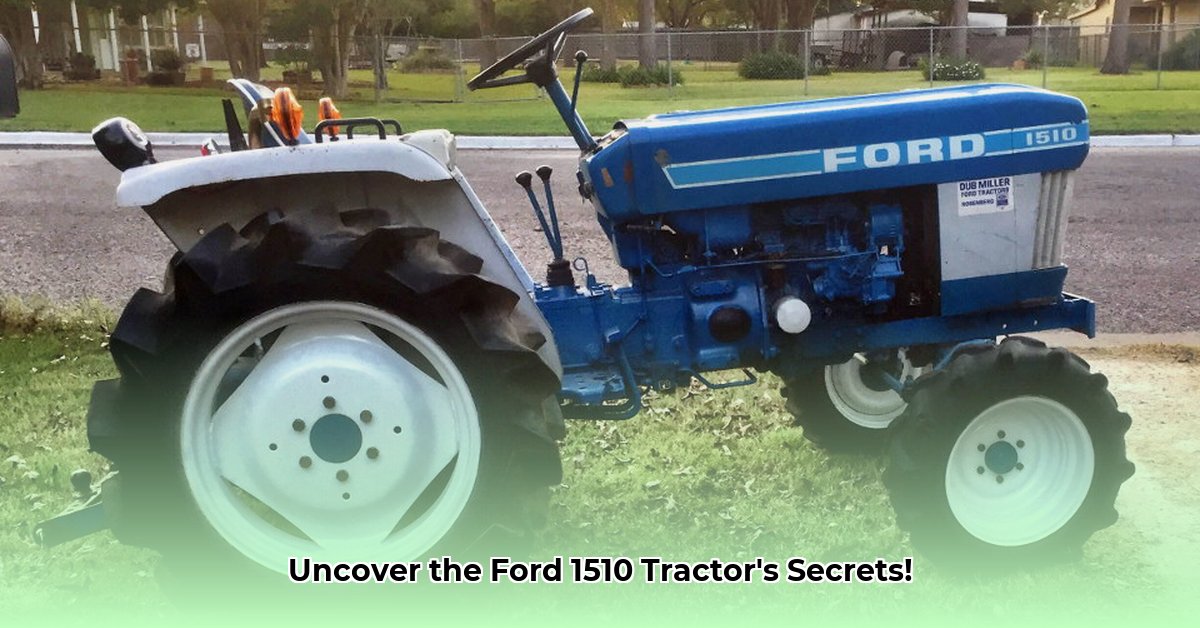
The Ford 1510 tractor, a stalwart of the 1980s agricultural landscape, remains a surprisingly relevant machine today. Its simple design, robust build, and relatively low cost make it an attractive option for budget-conscious farmers and hobbyists alike. This comprehensive guide delves into the 1510's technical specifications, market value, and provides essential advice for potential buyers. We'll explore its strengths and weaknesses, comparing it to modern tractors and outlining the steps needed to find and maintain a reliable 1510. For more on classic Ford tractors, check out this related resource.
Technical Specifications and Performance
The Ford 1510's power comes from a Shibaura K773 three-cylinder diesel engine, producing approximately 22 horsepower. While not a powerhouse by today's standards, its torque—the twisting force that enables pulling power—proves surprisingly adequate for many smaller-scale farming tasks, such as tilling, haying, and operating implements common on smaller properties. Isn't it remarkable how much work this modest engine can accomplish? The transmission, either unsynchronized or partially synchronized, offers 12 forward and 4 reverse gears. Top speed is around 12.5 mph, making it suitable for farm work but not highway travel. Both two-wheel and four-wheel drive versions were available, offering adaptability to varying terrains. The hydraulic system, though basic by modern standards, provides sufficient lift capacity (between 1160 and 1435 pounds) for typical implements and utilizes a Category 1 three-point hitch for wide attachment compatibility. Fuel efficiency, by modern standards, is modest.
Pros and Cons: Weighing the Value
The Ford 1510 presents a compelling blend of advantages and disadvantages compared to newer, more technologically advanced tractors.
Pros:
- Simplicity: Its uncomplicated mechanical design translates to fewer potential points of failure, potentially reducing repair costs and making maintenance more manageable for mechanically inclined owners. This simplicity might be surprisingly appealing in today's complex world of agricultural technology.
- Affordability: Used 1510s often sell at significantly lower prices than newer models, making them an accessible entry point for budget-conscious buyers.
- Parts Availability: Despite its age, replacement parts remain reasonably accessible through various channels, including agricultural supply stores and online marketplaces.
Cons:
- Lack of Modern Amenities: The 1510 lacks the power steering, electronic controls, and advanced hydraulic systems found in modern tractors.
- Increased Maintenance: As with any older machinery, regular maintenance is crucial to ensure reliable operation. It demands more hands-on care than its modern counterparts..
- Operator Comfort: Expect a less comfortable operating experience compared to modern tractors equipped with advanced ergonomic features.
Market Analysis: Finding Your Ford 1510
The current market value of a Ford 1510 varies significantly depending on conditions, hours of use, and included implements. Online marketplaces often list used tractors, and prices can range considerably. Remember that a higher asking price typically reflects better overall condition and possibly included accessories, such as a front-end loader. Thorough research is essential to determine a fair market price in your region.
Buying Guide: A Step-by-Step Approach
Purchasing a used tractor requires careful attention. Follow this guide to help you make a sound investment:
- Thorough Inspection: Before committing, conduct a meticulous inspection. Check the engine, transmission, hydraulics, and body for any damage, leaks, or signs of wear.
- Test Drive: A test drive is non-negotiable. Assess steering responsiveness, performance, and overall operation.
- Fluid Checks: Verify that all fluids (engine oil, transmission fluid, coolant, and hydraulic fluid) are at correct levels and in good condition.
- Documentation: Ensure all necessary paperwork (title, etc.) is present to confirm clear ownership and avoid legal complications.
- Price Negotiation: Based on your inspection, market research, and budget, negotiate a fair price with the seller.
Conclusion: A Classic with Staying Power?
The Ford 1510, a testament to simpler construction and rugged design, remains relevant in today's market for its affordability and relative ease of maintenance. Its simplicity has its advantages and drawbacks. Understanding both, coupled with a careful buying process, will help determine if a Ford 1510 meets your needs. Remember to factor in the costs of ongoing maintenance and potential repairs before making a purchase.